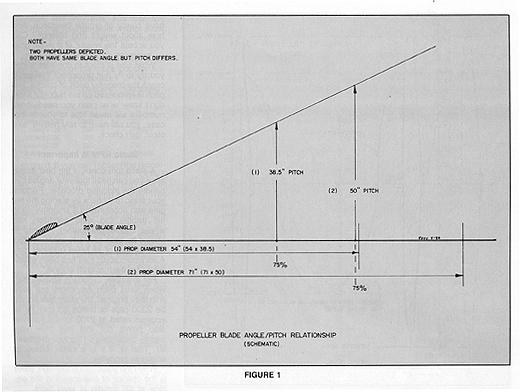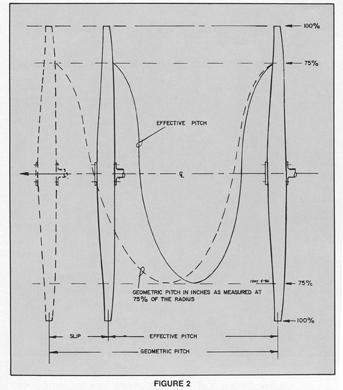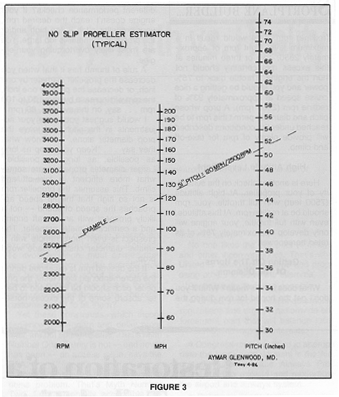The Fixed Pitch Propeller Dilemma
By Tony Bingelis (originally published in EAA Sport Aviation, August 1986)
Look through your old copies of Sport Aviation. There you will find much written about fixed pitch propellers; about blade tip formulas, nomograms for figuring how fast a prop of a certain pitch will move an airplane, articles about propeller efficiency, wood vs. metal propellers and every conceivable way of proving an airplane can or cannot fly that fast.
Have you noticed lately that most newly completed homebuilts, except for an occasional Pietenpol or Volksplane, of course, "cruise" over 200 mph? There are computer whizzes and armchair theorists who periodically challenge such claims and cite certain mathematical and aerodynamical "realities", but I for one do not intend to get into that hassle. I will, instead, offer a few suggestions for selecting your first propeller.
First propeller? Alas, 'tis true. Builders, like knights of old in search of the Holy Grail, continue to seek that elusive "ideal" propeller long after they have flown off their mandatory test flight hours. More than a few builders nurture the feeling that their aircraft performance doesn't quite live up to expectations. Others, after getting a few exciting hours under their belts, quickly learn that their local area landing strips are uncomfortably short or, due to the high elevations all around, would feel more secure if their airplane had a better climb. Unfortunately for them, some of the cruise speed they now enjoy will have to be sacrificed for a better climb performance. And so, the propeller selection dilemma surfaces.
Which is more important to you, a good cruise speed and a fair climb performance or vice versa? This is the first decision you must make.
Next, you must establish the maximum propeller diameter your airplane can accommodate. Determine this with the aircraft in a level (take-off) attitude. Measure the distance from the crankshaft to the ground and subtract 9 inches to allow for safe ground clearance. For example, if the hub-to-ground measurement is 45 inches, subtracting 9 inches will leave an effective radius of 36 inches. This limits your maximum allowable propeller diameter to 72 inches (36" x 2" = 72"). Incidentally, if you are the proud owner of a nose gear equipped aircraft, you have another concern. In the event the nose gear shock strut collapses, or the tire goes flat, will the remaining ground clearance (allow 2" to 3") be sufficient to save the prop?
Armed with the foregoing essentials, you will be better equipped to select the propeller you need. But, before proceeding, it may be helpful to review a few terms and definitions vital to any discussion of propeller selection and performance.
Blade Angle and Pitch Defined
Blade angle is the angle formed between the propeller's plane of rotation and the chord line of its airfoil section. Blade angle is an angular measurement and is expressed in degrees (see Figure 1).
Pitch, on the other hand, is the distance in inches that a propeller section will advance in one revolution. Both blade angle and pitch are measured at the airfoil section located at 75% of the blade radius, but apparently not always in the same manner. That invites the possibility that the blade angle you measure may not translate into the advertised pitch. It is, therefore, useless to try to compare propellers from different sources relying on pitch only.
Refer to Figure 2 and you will see that there is a difference between geometric pitch and effective pitch. The difference is called SLIP and is a measure of the propeller's efficiency. Understandably, the effective pitch will be zero when you are running the engine up on the ground with wheels chocked. In flight, however, propeller efficiency increases to as high as 85% to 90% during favorable flight conditions, and propeller slip is greatly diminished. For example: A propeller having a pitch of 65 inches will theoretically advance 65 inches in one revolution. But, if in reality, it only moves forward 52 inches in one revolution, its effective pitch would then be 52 inches and the propeller efficiency would be only 80%. (Slip is 13 inches or a 20% loss of efficiency.) An old military manual describes slip as the difference between the velocity of the air behind the propeller (caused by the propeller) and that of the aircraft with respect to the undisturbed air well ahead of the propeller.
Well, so much for that. Now, what can you do about getting a good propeller?
Propeller Options
Here they are:
1. You could buy a new certificated metal propeller, but brace yourself for a shock. The price of a certificated fixed pitch metal prop is staggering. For that twisted hunk of 2025T6 aluminum, having no moving parts, you will have to pay $1500 or more. How does that price tag for a hand-me-down, 135 mph prop design (originally developed for Cessnas, Piper, etc.) grab you?
Well, how about buying a new certificated wood propeller? A FAA approved wood prop (suitable for most certificated light aircraft) does have a somewhat more sane price tag - it costs only half as much as a metal propeller. It also has less than half the weight of a metal prop. This could be an important weight and balance consideration.
There is a third, more popular, source for new wood propellers. These are the custom-made propellers tailored especially to the homebuilt market. You can order one in almost any size you think you will need. These props are not FAA approved, so naturally do not command as high a price. For the most part, if you get the prop suited to your aircraft and engine it will usually be of excellent quality. Be advised, however, that the FAA can require you to fly more hours in your initial Flight Test Area if your airplane does not have an "approved" propeller/engine installation. In other words, when a non-aircraft engine and/or an uncertificated wood propeller are installed, the FAA generally mandates a longer test period. This is, FAA says, so you can prove the installation to be airworthy before they release you from the assigned test area.
Except for carving your own prop - and quite a few builders do - that about covers all the options you have for obtaining a new propeller.
What'll it be? $400 for a homebuilt custom-made wood prop, $600 for a certificated wood prop, or $1500 for a certificated metal propeller? With prices like that, it is essential to make the correct initial choice unless you want to join the increasing number of builders who are becoming involuntary collectors of mismatched propellers.
How About Buying A Used Metal Propeller?
You can, of course, buy a used propeller if you are willing to take the risk. The risk is greatest in buying a used metal propeller having an unknown history. You have no way of knowing if that propeller has been severely damaged and the tips straightened; or if the blades have been damaged that the damage was minor and within authorized repairable limits. There is always the possibility that someone may have straightened them a bit before taking the prop to a propeller shop for repair and rework. A reputable propeller repair shop will not knowingly rework a propeller that is bent beyond authorized repair limits, but they too can be fooled sometimes.
There is also the added danger that a used metal prop may have been cut down beyond the limits authorized by the manufacturer of the propeller. If so, such a prop can be an accident just waiting for a place to happen.
The Sensenich folks (makers of fine wood and metal propellers) liken a metal propeller's characteristics to that of a tuning fork. This is because each propeller has its own set of natural frequencies of resonance which is predetermined by the blade's length, thickness and weight distribution. When a propeller is designed for use on a particular model engine, great care is taken to tune that propeller so that no dangerous resonance peaks will occur within the operating range of that engine's rotational speed. So what happens? Along comes some builder who whacks off a few inches from each blade and then has additional pitch twisted into the blades. The delicately designed levels for the steady and vibratory stress cycles are exceeded - the metal begins to deteriorate from excessive flexing and a fatigue crack ultimately develops. Should this occur, it can result in a catastrophic failure of the propeller blade(s).
Who Has A Prop You Can Try?
Do you or a fellow builder own a spare propeller that you could try? If so, first find out whether that propeller hub will fit your engine. Lycoming engine flanges are not the same as those on Continental engines. Then, too, propeller bolt hole sizes vary. Naturally, Volkswagen engines have still another bolt pattern and the same can be said of other engine conversions. Anyhow, if the prop hub fits your engine, fine. Why not give it a try. I assume that you will have plenty of ground clearance. And how about weight and balance? Can you accept the weight of a metal prop - assuming it is metal?
What else is there to consider before you try to fly that propeller? You could check the propeller pitch, of course. The pitch is embossed on the hub. But if you don't know what pitch you need, those numbers will mean little to you. In that case, you will have to rely heavily on a static rpm check.
Static RPM Is Important
A static rpm check is the best assurance you can have that your engine can handle the installed propeller. Perform your static rpm check by starting the engine and accelerating it smoothly up to full throttle (no wind condition and wheels chocked, of course). The engine should be able to reach approximately 80% to 85% of its rated (redline) rpm. A minimum static rpm has been established for each aircraft engine.
For example, Lycoming advises that, when fixed pitch propellers are used with their engines, the static rpm should be 2300 plus or minus 50 rpm for all engines rated at 2700 rpm. Lycoming also points out that this may vary slightly depending on the type of propeller. That is, if it is a climb, cruise or economy propeller.
When the static rpm is too high, there is the chance of overspeeding the engine at full throttle in level flight . . . perhaps even during take-off.
On the other hand, there is this concern. If the recommended static rpm cannot be reached, it indicates that your engine is overtorqued (overloaded). In effect that means that your propeller diameter is too large, or that the pitch is too much, or both. This condition is detrimental to the engine if allowed to continue. Not only that, it is also fair warning that your propeller will not allow the engine to develop sufficient horsepower for a safe take-off!
Here are the recommended static rpm for some of the more popular engines used by homebuilts:
|
ENGINE |
STATIC RPM |
RATED RPM |
|
Continental A-65 |
1960 |
2300 |
|
Continental C-85 |
2200 |
2575 |
|
Continental C-90 |
2125 |
2475 |
|
Continental 0-200 |
2320 |
2750 |
|
Lycoming 0-235 |
2200 |
2600/2800 |
|
Lycoming 0-290 |
2200 |
2800 |
|
Lycoming 0-320 |
2300 |
2700 |
|
Volkswagen |
2900 |
3600/3800 |
In short, if you can't obtain the recommended minimum static rpm DON'T TRY TO TAKE OFF WITH THAT PROP . . . especially from a short runway! This caution is especially applicable for low power, direct drive VW engines that turn at a much higher rpm than standard aircraft engines. That 2900 rpm sounds high compared to a certificated aircraft engine but don't be fooled. Play it safe!
Although your propeller may meet the minimum static rpm criteria set by the engine manufacturer, you still may not be getting the performance you expected. There could be a number of reasons for this:
1. Your engine needs a "tune-up" (plugs, timing, harness, carburetor.)
2. Your Airspeed Indicator is inaccurate.
3. Your Tachometer is inaccurate.
You should check your engine and both instruments if you want to tweak the best performance possible out of your propeller. Use a Reed Tachometer or a Tach Chek to calibrate the tachometer. I am sure you can see that a slow indicating tachometer and/or a high reading airspeed indicator could really fool you by concealing the fact that your airplane is somewhat slower than the numbers would indicate. Conversely, it would be nice to learn that your airplane is really faster than either the tachometer or airspeed gage would have you believe.
Here are a few flight checks you can make after you have ascertained the accuracy of your tachometer. The results should tell you what needs to be done to your propeller, if anything.
Take-Off And Climb
Don't expect to get the rated rpm for take-off with a fixed pitch prop. If you do, by the time you reach level flight the engine will be winding up like a turbine and running way over its redline rpm. It is most unlikely, therefore, that with a properly pitched fixed pitch propeller you will be utilizing anywhere near the rated horsepower of the engine for takeoff.
Low Altitude Level Flight
Here is an important check for your propeller. Let's assume your engine is a Lycoming 0-320 (150 hp). Your prop should allow it to develop its maximum rated 150 hp at 2700 rpm using full throttle in level flight at sea level - assuming a standard day (temperature 59 degrees F, and sea level pressure of 29.92 Hg). Obviously, this sort of check is impossible for most of us unless we fly to some place called "Bad Water" in Death Valley where it is approximately 254 feet below sea level.
The closest you might come to those conditions would be a full throttle, level flight below 3000 feet early some morning when the air is nice and smooth. The engine rpm should turn up to approximately 5% over the rated 2700 (redline) rpm. This would result in a maximum level flight rpm of approximately 2850. Two or three minutes at this excess rpm certainly should not hurt the engine. Throttle back to 75% power and you should be getting a nice cruise speed at approximately 93% of redline rpm (2500 rpm). A prop whose pitch and diameter permit this rpm to be reached under the conditions described will provide plenty of rpm for take-off and climb.
High Altitude Level Flight
Here is another check on the suitability of your propeller. At high altitude (7500 feet) with full throttle, your rpm should be at redline rpm. At this altitude, even with full throttle, your engine will only develop approximately 75% of its rated horsepower.
Getting Off The Horns Of The Dilemma
What does all this mean? What if you don't get the hoped for rpm during the different performance checks? If your engine doesn't reach the desired rpm, your propeller pitch is too high and/or the propeller diameter is too large. You are most likely overtorquing your engine.
A rule of thumb has it that when you decrease the propeller diameter by one inch, or decrease the pitch by one inch, the rpm will increase by about 50 to 100 rpm . . . say, on the average, 80 rpm.
I would suggest you make your adjustments in the pitch and leave the prop diameter alone. You know what they say . . . "Keep your prop as long as possible, as long as possible." Larger diameter propellers are somewhat more efficient in take-off and climb. This assumes the propeller rpm is not so high that the tip speed approaches the speed of sound = not a likely prospect with an aircraft engine and a certificated metal propeller. The prospect is even more remote with a smaller diameter custom made wood prop.
If the desired rpm is exceeded during the aforementioned flight tests, the propeller pitch should be increased to better absorb some of the excess horse power. Most builder/pilots hate to run their engines over the rated rpm - not so much for concern that it will be detrimental to the engine as it is for the dislike for the high pitched noise of a fast turning powerplant. I keep hearing that many composite pilots (I mean pilots of composite aircraft!) habitually turn their 0-200 Continental at 2850 rpm. That might explain why many of these fast birds lay claim to a 200 mph "cruise". You think 2850 rpm is high for an engine rated at 2750 rpm? Cassutt racers are regularly clocked way over 200 mph turning the engines up to as high as 4000 rpm! RPM equate to horsepower, you know.
Naturally, you should operate your engine according to the manifold pressure limits and power curves made available by the engine's manufacturer. After all, what's the rush, amigo?



